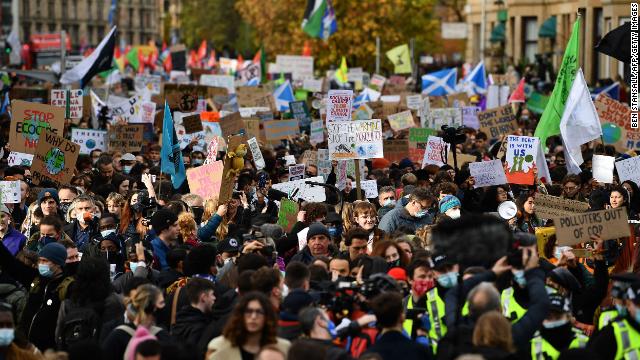
It’s been a long week at the COP26 climate conference in Glasgow and after a flurry of big announcements in the past few days, the theme of the day on Friday was the impact of climate change on future generations.
Here’s what happened if you missed it.
“Green wash festival”
The focus turned away from the suits and briefcases in the conference venue to the city center, where thousands of kids made sure their voices were heard by marching though the town.
Young activists poured into Glasgow from all over the world, demanding action from leaders at a Fridays for Future demonstration.
The headliner of the event, Greta Thunberg, called the COP event a “Global North greenwash festival” and said “it should be obvious that we cannot solve a crisis with the same methods that got us into it in the first place.”
A word about the “good news” from IEA
Several analysts have poured cold water over the International Energy Agency’s (IEA) assessment that global warming could be limited to 1.8 degrees Celsius above pre-industrial levels by 2100, if all COP26 commitments made as of Wednesday night are fulfilled on time. The IEA was asked by the COP26 President Alok Sharma to keep tabs on the pledges.
Mark Maslin, a professor of earth sciences at University College London, wasn’t convinced. “This is irresponsible, because this is only true if all the country pledges are met and their policies are 100% effective — which they never are,” Maslin told CNN. “It’s almost like the IEA wants to tell everyone the job is done and we have solved climate change, whereas we climate scientists know we are still a long, long, way from 2 degrees let alone 1.5 degrees.”
Al Gore says the tools are in our hands
Former US Vice President Al Gore had a lot of praise for the young people marching through Glasgow on Friday. Speaking during the official conference, he said the world leaders need to “legitimize their expectations for a future that is worthy of them.”
“We can do so but we must put the period of delay and distraction and expedience in the past, recognize that we have entered a period of consequences and make it a period of solutions,” he said.
Gore, a fierce climate change advocate, said humanity has the power to save the world, if the political will could be mustered. “It’s as if we can throw a switch and save the future of our civilization,” Gore said. He also emphasized a common theme this week: that promises are great, but they must be kept in order to have an impact.
“We have the tools that we need to solve the crisis. We have heard pledges that will move us in a long direction toward these solutions. We must ensure that these pledges are kept,” Gore said.
America’s plan to make carbon capture cheaper
US Secretary of Energy Jennifer Granholm announced Friday the Department of Energy has a new goal: Dramatically reduce the cost of removing carbon dioxide from the atmosphere.
Granholm said Friday at COP26 that the DOE’s goal is to reduce the cost to $100 per ton of carbon by 2030. Right now, the department estimates it costs roughly $2,000 per ton.
Scientists say removing greenhouse gas from the atmosphere is crucial to achieving net-zero emissions by 2050 and keeping global warming below 1.5 degrees Celsius. But the technology is still relatively young and incredibly expensive. It also needs to be scaled up significantly in order to make a dent in what humans have already emitted.
Negotiators hard at work
The first week of the COP26 summit will wrap up on Saturday and the negotiations of some of the key aspects of the Paris Agreement are well under way. The national delegates are still trying to figure out how to implement article six of the treaty, which sets out the need for carbon emission trading.
They are also attempting to find an agreement on emission cutting transparency rules, which include questions like how often countries need to report their progress and how to avoid double counting.







More News
Opinion | Seven Theories for Why Biden Is Losing (and What He Should Do About It)
Critics Fault ‘Aggressive’ N.Y.P.D. Response to Pro-Palestinian Rally
Korean Fried Chicken to Save Your Sunday